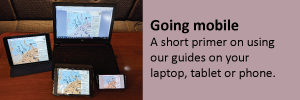R2AK: Race to the future

Race to Alaska participants congregated at the Causeway Docks in Victoria to prepare for the official start to the race.
After the 40-mile breakdown “funzie” from Port Townsend on June 23, the crews congregated at the Causeway Docks in front of the Empress Hotel for a two-day break to fine tune their rigs for the official start of the second annual race yesterday.

Of course, the fine tuning mostly involved the human propulsion systems. Some vessels are sticking with the tried and true, throwing a paddle over the side and digging in.
Some have simple or elaborate rowing systems with ingenious sliders, sometimes hung from the boat.
The pedal systems, either to power propellers or fish-like fins capture the most interest. Some crews, including a few of the larger cats and trimarans, claim they can maintain 4-6 knots under pedal power.

After oars, pedal-powered props were the most popular form of propulsion.
So I was thinking two things as Lynne and I walked the docks to watch the preparations and hand out Salish Sea Pilot bookmarks to promote our guides.
(Lynne’s pitch, as she hands someone a bookmark, is to say she hopes they “don’t mind if we shamelessly promote our guides.” My pitch, meanwhile, is to say “please don’t think of this as a product promotion, but as a tool to help you find your page.” Her pitch is probably more honest.)

So-called flappers, used on kayaks and other craft, provided amazing push for such a tiny device.
Oh yeah, the two things I was thinking… One was how I could crowd-fund our own entry into next year’s race since our 10-ton sailboat is not the easiest to row.
The other was that, given the environmental and possible future cost issues involved with internal combustion, or some amazing advancement in another non-polluting sustainable energy technology, human power is the future for small cruising craft.
And races like R2AK might be from where such an advancement comes.
The race has few rules. Propulsion must be by wind or human power. No engine aboard, even “just in case”.
No support. You can go ashore for provisioning or repairs, but services cannot come to you.

Tiny tris are popular among racers this year.
Take any route you want as long as your boat crosses two waypoints — reached by transiting Seymour Narrows north of Campbell River and Lama Passage southeast of Bella Bella. Every vessel carries a SPOT transponder to ensure they adhere to the rules.
A sweep boat sets off from Port Townsend either when a boat first crosses the finish line or July 15, whichever comes last, and travels about 75 nautical miles a day, eliminating stragglers as it passes them along the 750-mile course to Ketchikan.
Beyond that the world is your oyster.
The two waypoints are strategic in that they keep the vessels “inside” where the route is determined as much by land as it is by prevailing winds. The lightest, fastest, most efficient sailboat will need some human power to complete the race.

Developments in human propulsion could transform sailing in the Salish Sea, where summer winds can be virtually nonexistent for weeks on end.
It could bring a new trend in cruisers. Lighter, faster, with room for two or three crew, rather than room for six which is rarely if ever filled.
Watching the boats move out, opens your eyes to the possibilities.


















